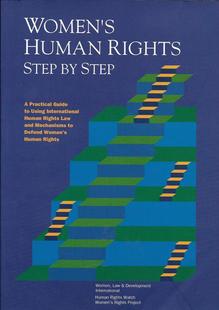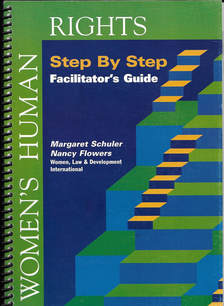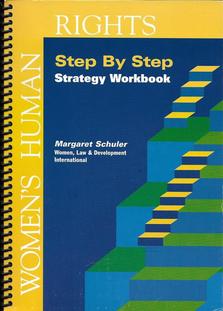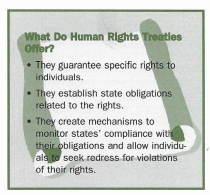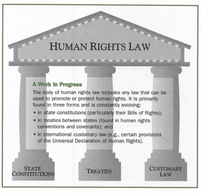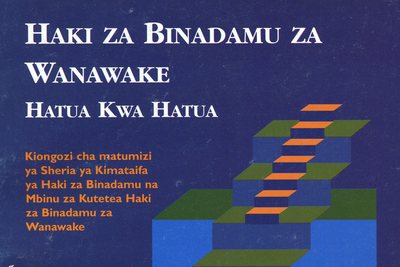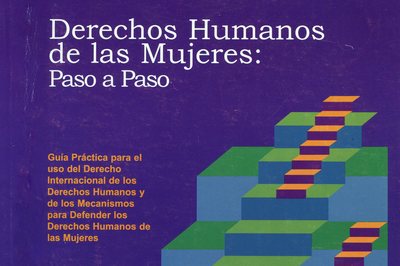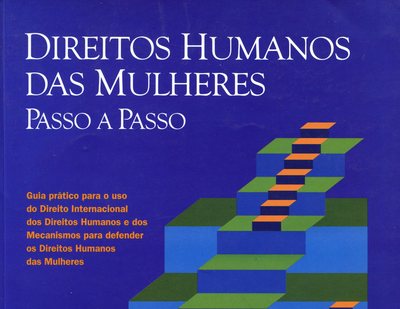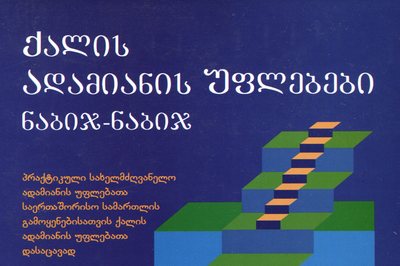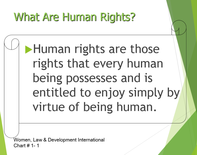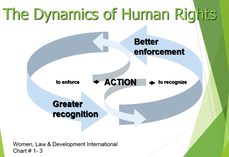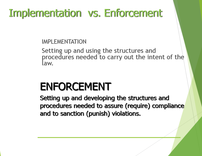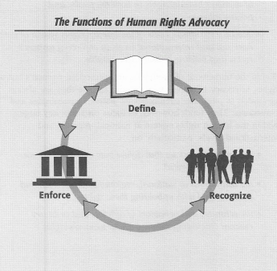
©
Margaret Schuler
Adopted and Maintained by PARTNERS FOR LAW IN DEVELOPMENT (PLD INDIA)
as part of the digital Feminist Law Archives
Adopted and Maintained by PARTNERS FOR LAW IN DEVELOPMENT (PLD INDIA)
as part of the digital Feminist Law Archives
Between the 1985 and 1995 UN World Conferences on Women in Nairobi Kenya and Beijing China, human rights strongly emerged as a key issue for women. Women’s activism around the 1993 UN Human Rights Conference in Vienna made the UN and national governments begin to take the issue seriously. With the slogan “women’s rights and human rights,” women activists challenged the neglect of women and their rights in the national and international spheres and argued that the improvement of women’s status anywhere depends on advancing their rights everywhere.
During this time, WLDI contributed to the effort by clarifying the issues and strategies related to women’s human rights with several initiatives, including “Claiming our Place,” 1993, “From Basic Needs to Basic Rights,” 1995, “Support for the Special Rapporteur on violence Against Women, covering State Responses to Domestic Violence and Rape, Gender Violence as War Crime,” etc., 1996-1998. (These will be covered in detail the “Advocacy” section of this Website.) Despite growing awareness of the concept among activists and some agencies at the UN, it became all too apparent that slogans are not enough. WLDI was aware that many women were unaware of their human rights, had no knowledge of the women’s human rights movement and see the human rights system—to the extent they were aware of it at all—as something abstract and beyond their reach. Thus, while activism had clearly made women’s human rights more visible, the challenge was to make them more accessible.
WLDI was clear that human rights literacy, a variation of legal literacy, needed to include not only awareness but the capacity to assert rights by understanding the various levels of human rights protections and their institutional mechanisms of enforcement, recognizing the legal and political options and alternatives available and acquiring the skill to shape the strategies and alliances that are fundamental to the assertion of rights.
During this time, WLDI contributed to the effort by clarifying the issues and strategies related to women’s human rights with several initiatives, including “Claiming our Place,” 1993, “From Basic Needs to Basic Rights,” 1995, “Support for the Special Rapporteur on violence Against Women, covering State Responses to Domestic Violence and Rape, Gender Violence as War Crime,” etc., 1996-1998. (These will be covered in detail the “Advocacy” section of this Website.) Despite growing awareness of the concept among activists and some agencies at the UN, it became all too apparent that slogans are not enough. WLDI was aware that many women were unaware of their human rights, had no knowledge of the women’s human rights movement and see the human rights system—to the extent they were aware of it at all—as something abstract and beyond their reach. Thus, while activism had clearly made women’s human rights more visible, the challenge was to make them more accessible.
WLDI was clear that human rights literacy, a variation of legal literacy, needed to include not only awareness but the capacity to assert rights by understanding the various levels of human rights protections and their institutional mechanisms of enforcement, recognizing the legal and political options and alternatives available and acquiring the skill to shape the strategies and alliances that are fundamental to the assertion of rights.
The "Step by Step" Project
To this end, WLDI worked over several years to develop a comprehensive educational program on women's human rights, that included
Following the publication of the manual, Women’s Human Rights Step By Step, WLDI used it as the primary resource for a global capacity-building program aimed at developing a larger and more skilled community of women’s human rights advocates (More on this in the Capacity Building section of this website). Over several years WLDI had the unique opportunity to develop, use, and test ideas, materials, and approaches to advocacy and to training in many different contexts. Through application, evaluation, and modification, we identified essential skills and information that activists need to master before becoming effective advocates. These were incorporated into a core curriculum and facilitator’s guide, prepared by me and Nancy Flowers to supplement the information contained in Women’s Human Rights Step by Step.
Finally, as part of this educational, capacity building, effort, we included a strategy planning workbook, as a practical guide to developing a women's human rights strategy.
- a manual that contained the core content of women's human rights at international and national levels,
- a facilitator's guide to a course curriculum to promote learning processes and
- a strategy workbook as a practical guide to developing a human rights strategy.
Following the publication of the manual, Women’s Human Rights Step By Step, WLDI used it as the primary resource for a global capacity-building program aimed at developing a larger and more skilled community of women’s human rights advocates (More on this in the Capacity Building section of this website). Over several years WLDI had the unique opportunity to develop, use, and test ideas, materials, and approaches to advocacy and to training in many different contexts. Through application, evaluation, and modification, we identified essential skills and information that activists need to master before becoming effective advocates. These were incorporated into a core curriculum and facilitator’s guide, prepared by me and Nancy Flowers to supplement the information contained in Women’s Human Rights Step by Step.
Finally, as part of this educational, capacity building, effort, we included a strategy planning workbook, as a practical guide to developing a women's human rights strategy.
The Step by Step Manual
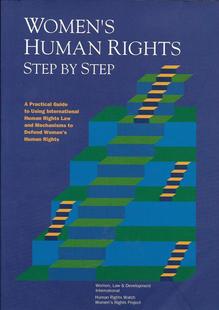
The Step by Step manual was the result of a collective process, rooted in our own experience and in consultation with other practitioners and scholars. Our board of directors, which included Dorothy Thomas, Director of Human Rights Watch Women’s Rights Project, our collaborating organization, and Florence Butegwa, WLDI board chairperson, all gave input into articulating the need and purpose of the book, and ultimately its design. There were four principle writers. Florence Butegwa wrote the chapter on the concept of human rights (chapter 1). Julie Mertus wrote most of the chapters on the international, regional and national human Rights systems (chapters 2, 3 & 4), Dorothy Thomas wrote the chapter on investigating and documenting violations (chapter 6) and I wrote the advocacy (chapters 5 & 7). Dorothy and I wrote the Introduction. In addition, we counted on a strong pool of advisors who generously vetted the work as it progressed, and contributors of case studies and other materials. For a complete list of contributors, and acknowledgements see the list here. Contributors
Purpose of the Manual
Recognizing that without mastery of technical concepts and skills, women’s human rights advocates are too often left with little to work with but slogans and enthusiasm. The Step by Step manual was developed to fill this gap. It provides an educational tools designed to:
Recognizing that without mastery of technical concepts and skills, women’s human rights advocates are too often left with little to work with but slogans and enthusiasm. The Step by Step manual was developed to fill this gap. It provides an educational tools designed to:
- help women’s rights advocates appreciate the relevance and importance of human rights law and mechanisms in the promotion and defense of women’s rights;
- provide information on how to use the human rights system at national, regional and international levels;
- explain in some detail the importance and methods of documenting and reporting violations of women’s human rights;
- outline key advocacy strategies that can be used to promote women’s human rights; and
- demonstrate, through cases and experiences, how women’s human rights advocates are already using the human rights system to enforce their rights.
Organization of the Manual
The manual is organized into six chapters covering various aspects of women’s human rights advocacy. The first chapter presents key human rights concepts and their relevance to women’s rights. Subsequent chapters introduce and explain different mechanisms and strategies for enforcing women’s human rights at national, regional and international levels and the challenges still facing women’s human rights advocates in these areas.
Chapter One: International Human Rights
Introduces the human rights framework and its significance as a tool for addressing women's Human rights.
Chapter Two: The UN Human Rights System
Describes International human rights systems and mechanisms and explains how they work and how to access them.
Chapter Three: Regional Human Rights Systems
Describes Regional human rights systems and mechanisms and explains how they work and how to access them.
Chapter Four: National Human Rights Systems
Describes National human rights systems and mechanisms and explains how they work and how to access them.
Chapter Five: Human Rights Advocacy Introduces and explains the concept of human rights advocacy for demanding accountability for women's human rights and explores characteristics of effective advocacy efforts.
Chapter Six: Documenting Human Rights Violations
Describes, step-by-step the process of investigating and documenting violations of women’s human rights and reporting them to the human rights community.
Chapter Seven: Guide to Human Rights Advocacy
Presents a step-by-step guide for constructing a strategy together with questions and issues needing resolution at each step of the way.
The Appendices
Offer reference materials including a glossary of terms, a list of instruments, and an address list of human rights offices in various countries and of institutions associated with the mechanisms covered in this manual.
The manual is organized into six chapters covering various aspects of women’s human rights advocacy. The first chapter presents key human rights concepts and their relevance to women’s rights. Subsequent chapters introduce and explain different mechanisms and strategies for enforcing women’s human rights at national, regional and international levels and the challenges still facing women’s human rights advocates in these areas.
Chapter One: International Human Rights
Introduces the human rights framework and its significance as a tool for addressing women's Human rights.
Chapter Two: The UN Human Rights System
Describes International human rights systems and mechanisms and explains how they work and how to access them.
Chapter Three: Regional Human Rights Systems
Describes Regional human rights systems and mechanisms and explains how they work and how to access them.
Chapter Four: National Human Rights Systems
Describes National human rights systems and mechanisms and explains how they work and how to access them.
Chapter Five: Human Rights Advocacy Introduces and explains the concept of human rights advocacy for demanding accountability for women's human rights and explores characteristics of effective advocacy efforts.
Chapter Six: Documenting Human Rights Violations
Describes, step-by-step the process of investigating and documenting violations of women’s human rights and reporting them to the human rights community.
Chapter Seven: Guide to Human Rights Advocacy
Presents a step-by-step guide for constructing a strategy together with questions and issues needing resolution at each step of the way.
The Appendices
Offer reference materials including a glossary of terms, a list of instruments, and an address list of human rights offices in various countries and of institutions associated with the mechanisms covered in this manual.
The Step by Step manual was published in 1997. As women around the world took notice of the new book on women's human rights, the need for translation into other languages became imperative. Working with local groups and donors in various countries, Step by Step was funded, translated, published and distributed across the globe. By 2003, it had been translated into 15 languages.
Step by Step, translated into various languages.
|
|
To learn about and download the Manual click here:
Women's' Human Rights Step by Step |
Step by Step Facilitator's Guide
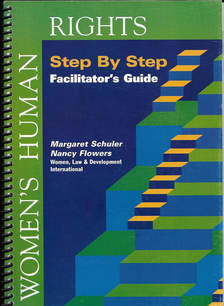
Since its publication in 1997, Women’s Human Rights Step by Step became an invaluable resource for women’s rights activists around the world. The core curriculum, contained in the Facilitator’s Guide was the outgrowth of several years of application, evaluation, and modification of content and methods. Together with Nancy Flowers, we designed a program to help people develop the critical set of skills and knowledge needed for human rights advocacy. This approach, the “WLDI Step-by-Step Advocacy Method” is, thus, an outcome of a process of engagement with women from different parts of the world, with varying levels of skills and knowledge, from diverse fields in addition to law, and in the context of actually doing advocacy. The Guide was published in 2003.
The WLDI Approach to Women's Human Rights Advocacy
In addition to understanding the structure and workings of the international human rights system, WLDI identified five main areas of competency required to carry out effective human rights advocacy. Advocates should be able to:
1. Frame a problem in human rights terms. This requires being able to:
Perhaps the most innovative contribution of the WLDI methodology is the manner in which it systematically links advocacy with the human rights framework. One of the participants put it this way:
In addition to understanding the structure and workings of the international human rights system, WLDI identified five main areas of competency required to carry out effective human rights advocacy. Advocates should be able to:
1. Frame a problem in human rights terms. This requires being able to:
- identify the right violated, clarifying how the right was violated and who committed the violation
- appreciate the role and responsibility of the state in relation to the violation
- grasp the scope and limitations of law as a tool for change
- recognize the interrelation of the substance of the law (what the law says), the structure of the law (how the law is applied and enforced), and the culture of the law (how people regard the law)
- know whether the problem is the violation of a protected right or the lack of a defined right
- recognize that unless a problem can be framed in human rights terms, it will not lend itself to a human rights strategy
- analyze the gender dimension of a problem (e.g., discrimination, gender gaps)
- recognize different categories of women’s human rights and the challenges that accompany them
- identify where the problem (rights violation) is addressed in human rights instruments
- recognize whether a resolution or remedy can be found at the national level or whether an international mechanism is relevant
- select the appropriate enforcement mechanisms to apply
- understand that the problem and the solution always include a cultural dimension—not just a legal one—that should he addressed in the solution
- identification of the “problem,” i.e., a human rights violation
- analysis the problem which spells out the right involved, explains how the right is being violated, identifies the violator(s) and considers the political context
- definition of outcomes with objectives set strategically, demands or claims clearly articulated, criteria for success spelled out,
- a strategy design including: appropriate political and legal actions, potential allies and opponents targeted, how contextual and political variables will be addressed, the who, what, when, where, and how of the actions to be taken
- a written plan
- a concise way to communicate the strategy
- an ongoing process to evaluate the strategy
- strong organization and leadership
- a compelling human rights issue with capacity to gain public support
- a clear definition, analysis and documentation of the issue, including showing that a right exists, proving that a violation of the right has occurred and demonstrating that the state has responsibility
- an appreciable constituency or support groups
- effective communication and education
- visible mobilization and action
Perhaps the most innovative contribution of the WLDI methodology is the manner in which it systematically links advocacy with the human rights framework. One of the participants put it this way:
- “For me, understanding how to systematically construct, design, implement, monitor and evaluate an advocacy strategy' in women’s human rights is completely new. The advocacy strategy' concept is an important element that I want/need to incorporate into my work method. I mean, for the most part women and organizations do advocacy in a non-strategic way. We do some advocacy actions but we don't really plan them. We think about what is important, we look for how to take advantage of the political context, the media and so on, but we have not had instruments and guidelines that could help us to link and understand all the components that we need to analyze in order to design and implement an effective advocacy strategy. We have done advocacy in a much more intuitive than strategic way. We have worked based on our many years experience working as activists....but now, with the WLDI structured approach to help us in developing our own advocacy strategies; it will add a greater quality to our work.”
Organization of the Guide and Course
The facilitator’s guide focuses on the essential information needed to use the human rights framework for advocacy.
Unit 1: Human Rights Fundamentals
- Topic 1: Definitions and History
- Topic 2: The Universal Declaration of Human Rights
- Topic 3: The International Bill of Rights
- Topic 4: The UN Human Rights System
- Topic 1: What is Enforcement?
- Topic 2: The UN Enforcement System
- Topic 3: Enforcement Procedures
- Topic 4: Evaluating Enforcement Mechanisms
- Topic 1: What Are Women's Human Rights?
- Topic 2: The Development of the Women’s Human Rights Movement
- Topic 3: Achievements of the Women’s Human Rights Movement
- Topic 4: Recognition of Women’s Human Rights
- Topic 1: Law as a Tool for Change
- Topic 2: Strategies and the Legal System
- Topic 3: Human Rights Advocacy
- Topic 4: Effective Human Rights Advocacy
- Topic 5: Developing and Refining Your Strategy
This facilitator’s guide and course serves to enhance the use of its core text, Women’s Human Rights Step by Step. It also draws upon the following supporting materials, including the
- Women's Human Rights Step by Step: Advocacy Workbook, which supplies the core content and discussion questions for Unit 4: Women’s Human Rights Advocacy.
- Power Point charts for each unit
- Copies of worksheets to accompany learning activities
- Copies of case studies for use in learning activities
- Copies of International regional human rights documents
Structure of the Units
Each unit has five elements: key concepts, core content, discussion questions, learning activities and slides and charts.
Each unit has five elements: key concepts, core content, discussion questions, learning activities and slides and charts.
- Key Concepts
A list of the core ideas to be covered in the unit. - Core Content
The core content section summarizes the concepts essential to the unit that are further enhanced by charts, explanation, discussion, and other interactive learning activities. Words and phrases printed in boldfaced type are defined in the Glossary of the core text, Women’s Human Rights Step by Step. - Discussion Questions
A series of questions cover the main points of the content. These questions are used to enhance learning and also to help the facilitator evaluate whether the material has been understood. - Learning Activities Although facilitators are encouraged to develop their own learning activities, a set of structured activities is offered for use in presenting or reinforcing the main concepts of the unit.
- Slides and charts. PowerPoint slides and worksheets reinforce the learning process. Worksheets are labeled with the name and number of the activity for which they are intended. All these are available for download.
|
|
To learn about or download the Facilitator's guide and materials, click here:
Step by Step Facilitator's Guide |
Step by Step Strategy Workbook
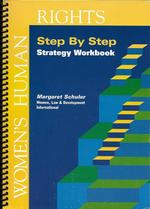
Purpose of the Workbook
This workbook is intended to help women’s rights advocates and activists make connections among several key concepts involved in “human rights advocacy.” It supplements the material contained in the Women’s Human Rights Step by Step manual, adding analytical tools for understanding the role of law in society and incorporating a structural analysis of the issues into a strategy design. The various sections lay out key concepts and provide working definitions. They also offer step-by-step guidelines for working with the concepts and integrating them into concrete action strategies that effectively advocate for the rights of women.
The need for Definition
The use of terms can sometimes be a source of confusion, especially when people use different words for the same thing, or when the same term is used to denote different things. In today’s world “democracy,” “civil society,” “advocacy,” and a host of other “in” words bounce around freely, but often without the precision that should be shared by everyone in the dialogue. Moreover, our thought and analysis are circumscribed by the terms we use. Often, even pioneers do not recognize their own excellent and innovative contributions due to their limited lexicon. On the other hand, rhetorical clichés become devoid of meaning by the obligatory character of their use. It is popular to speak of “mobilization” and “empowerment,” for example, but what do they really mean and how do we do them? “Educating women about their rights” is another popular phrase. But what kind of education is this phrase referring to? And, of course, “women’s rights are human rights” is a phrase we all use, but how many of us can really define what it means or know to what degree our meaning is shared by everyone else who uses the phrase? In this context it is important, therefore, to identify functional categories or concepts that will help articulate a new and deeper comprehension of the structure and utility of our efforts.
This workbook proposes a series of simple definitions and categories to help name our experiences.
First, it explores the role of law and its affect on women and presents a conceptual approach for identifying the major legal issues facing women in the world today. Second, it explores the meaning of action strategies and advocacy strategies and how to develop them. Third, it explores the power of human rights as an organizing framework for engaging in effective advocacy.
Part I
“Definitions and Concepts” lays out the framework, definitions and concepts needed to design a powerful human rights advocacy strategy.
Part II
“Developing and Refining your Strategy” presents a step by step process for designing and evaluating an advocacy strategy.
First, it explores the role of law and its affect on women and presents a conceptual approach for identifying the major legal issues facing women in the world today. Second, it explores the meaning of action strategies and advocacy strategies and how to develop them. Third, it explores the power of human rights as an organizing framework for engaging in effective advocacy.
Part I
“Definitions and Concepts” lays out the framework, definitions and concepts needed to design a powerful human rights advocacy strategy.
Part II
“Developing and Refining your Strategy” presents a step by step process for designing and evaluating an advocacy strategy.
|
|
|
Continue on to:
|


